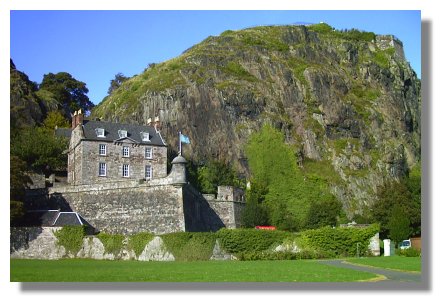
Scottish Castles Photo Library
- Dumbarton Castle

"Dun Breatann" or fortress of the Britons (also called "Alcluith" - the Clyde Rock), has a recorded history as a stronghold which is longer than any other fortification in Britain. The earliest reference is to St Patrick who wrote in 450AD to the King of Strathclyde about a raid by his followers on some of the Irish Saint's converts.
In the dark ages, the Kingdom of Strathclyde, with its capital at Dumbarton, spread south from the river Clyde to cover much of south-west Scotland. They had to contend with the Kings of Rheged and Elmet further south in Northumbria and Cumbria, the Picts to the north and Dalriada (the home of the Scots, originally from Ireland) to the west. In 756 a combined force of Picts and Northumbrians besieged and took Alcluith and there are records of "the burning of Clyde Rock" in January 780.
In 1018 Malcolm II was able to put his grandson Duncan (the predecessor of Macbeth) on the throne of Strathclyde. Duncan governed Strathclyde and when he succeeded Malcolm II, Strathclyde became part of the emerging Scottish kingdom.
When Edward I marched into Scotland in March 1296, he captured Dumbarton Castle and installed his own goverenor there. One of the governors, Sir John Stewart of Mentieth, played an important part in the capture of William Wallace on 5th August, 1305.
After the death of Bruce (at nearby Cardross) in 1328, his young son King David II was under threat following the Scottish defeat at the Battle of Halidon Hill in 1333. He was brought to Dumbarton Castle for safety and the following year King David II sailed from Dumbarton to France, returning seven years later
In the 16th century, Mary Queen of Scots stayed in Dumbarton Castle for five months after the disastrous Battle of Pinkie Cleuch (10th September, 1547) before sailing to France to marry the Dauphin. When Mary Queen of Scots was defeated at the Battle of Langside on 13th May, 1568, and fled to England, the Governor of the Castle, Lord Fleming, remained loyal to her and held Dumbarton Castle in her name until 1571. The Castle was eventually captured by Captain Thomas Crawford who led 100 men up the rocks and ramparts on the northern side, which everyone thought were impregnable.
See also Places to Visit - Dumbarton Castle for more information and illustrations.
Return to the Castles Photo Library Index
or go to the next castle:  Dunbar Castle.
Dunbar Castle.
Where else would you like to go in Scotland?
Where else would you like to go in Scotland?

